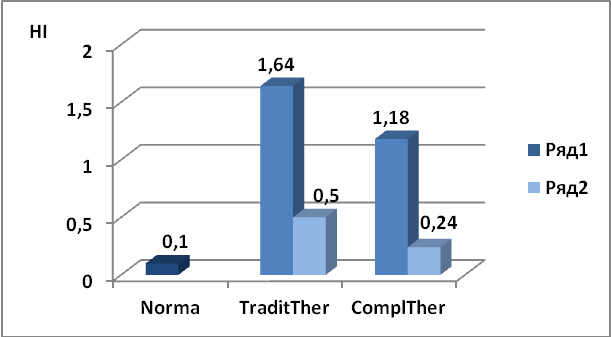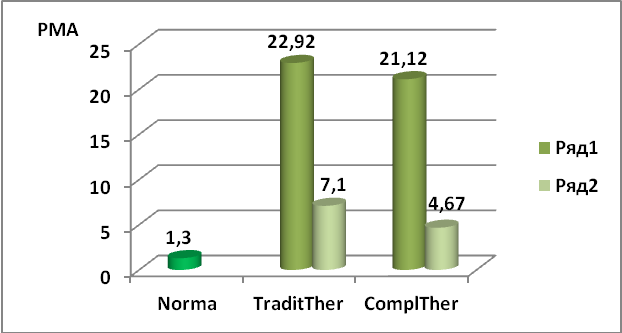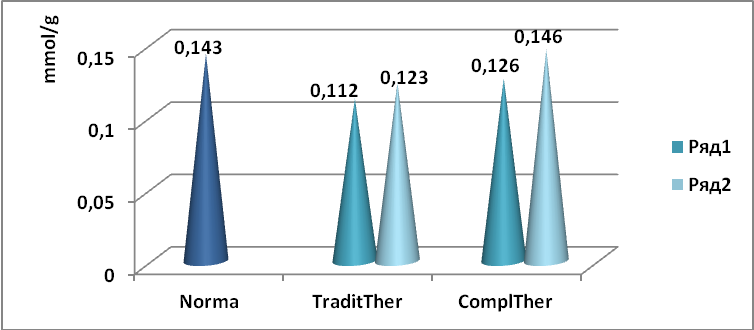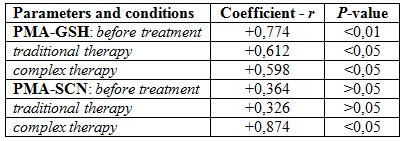EFFECT OF ANTIHOMOTOXIC THERAPY IN CHILDREN WITH GINGIVITIS
Гаврилюк Л.А.1, Шевченко Н.В.2
1ORCID: 0000-0001-6746-4889, Доктор медицинских наук, Профессор, 2ORCID: 0000-0002-3135-2370, Кандидат медицинских наук, Доцент, Государственный университет медицины и фармации им. Н. Тестемицану, Кишинёв, Молдова
ЭФФЕКТ АНТИГОМОТОКСИЧЕСКОЙ ТЕРАПИИ У ДЕТЕЙ С ГИНГИВИТОМ
Аннотация
Гингивит - это инфекционное заболевание со специфическими характеристиками. Компоненты слюны являются отражением метаболического состояния пациента и имеют клинико-диагностическое значение при воспалении тканей ротовой полости. Целью нашего исследования было изучить влияние антигомотоксической терапии в сравнении с традиционной терапией на некоторые компоненты слюны 37 детей с гингивитом средней степени тяжести. Результаты исследования показали, что до начала терапии содержания тиоцианата (SCN-ионов) и восстановленного глутатиона (GSH) были пониженными, а содержание белка – повышенным в слюне 12-летних детей с гингивитом. Комплексная терапия, включающая мазь Traumeel S и Coenzyme compositum, также как и традиционная (гель“Metrogyl-denta”), повышали содержания тиоцианата и GSH и понижали содержание белка в слюне пациентов с гингивитом. Комплексная терапия была эффективней традиционной и более существенно понижала индексы гигиены (HI) и PMA.
Ключевые слова: гингивит, глутатион, Coenzyme compositum, HI, PMA, Traumeel S
Gavriliuc L.A.1, Sevcenco N.V.2
1 ORCID: 0000-0001-6746-4887, MD, Professor, 2 ORCID: 0000-0002-3135-2370, MD, Associate Professor, N.Testemitanu State University of Medicine and Pharmacy, Chisinau, Moldova
EFFECT OF ANTIHOMOTOXIC THERAPY IN CHILDREN WITH GINGIVITIS
Abstract
Gingivitis is an infectious disease with specific characteristics. Salivary indices are a reflection of the patient’s metabolic state and have clinical diagnostic importance in patients with oral tissue inflammation. The aim of our study was examination of influence the complex antihomotoxic therapy on the certain salivary components in 37 children with mild gingivitis in comparison with the traditional approach. The results of the study before the therapeutic course showed that the contents of thiocyanate (SCN- ions) and reduced glutathione (GSH) were decreased, and protein amount was increased in the saliva of 12 years children with gingivitis. Complex therapy, including Traumeel S ointment and Coenzyme compositum, also as the traditional therapy (“Metrogyl-denta” gel) increased the concentration of thiocyanate and GSH, and decreased the content of protein in the saliva of patients with gingivitis. Complex therapy was more effective treatment than the traditional one and decreased oral hygiene indexes (HI) and PMA indexes more significantly.
Keywords: gingivitis, glutathione, Coenzyme compositum, HI, PMA, Traumeel S
Introduction
Oral microbiota is responsible for periodontal diseases like gingivitis, periodontitis, etc. Gingivitis is characterized by an increase in the number and variety of inflammatory cells in the gingival surrounding the tooth root surface [1, 5]. Inflammation of periodontium is a currently imperative problem in dentistry. The spread of gingivitis in children has increased to 30-65% of the population. Search for the newest and most effective methods of treatment of gingivitis at the early stage of the disease holds vital significance in modern dental practice. The antihomotoxic preparations Traumeel S ointment and Coenzyme compositum (“Heel”, Germany) may be recommended for effectively targeting this problem. Traumeel S consists of 14 natural components, and Coenzyme compositum – 26, which are the metabolites of Krebs cycle, the central metabolic pathway of the human organism. These antihomotoxic preparations are homeopathic substances with protective, antioxidant, antitoxic, anti-inflammatory and anti-allergic properties [8]. Usage of these preparations is based on their composition, properties, mechanism of action and possibility to use in oral application. Salivary indices (parameters) are a reflection of the patient’s metabolic state and have clinical-diagnostic value in patients with inflammation of oral tissues [2, 7].
The aim of this study was comparative examination of complex antihomotoxic therapy in children with mild gingivitis in comparison with traditional therapy.
Material and methods
The thirty-seven children (12 years old) with mild gingivitis and 20 healthy children (control group) were examined in this investigation. Selected children with mild gingivitis were divided in two groups: 1- patients treated traditionally, with conservative method, using “Metrogyl-denta” gel; 2- patients treated with complex therapy, including Traumeel S ointment and Coenzyme compositum (“Heel” GmbH, Baden-Baden, DE). The traditional preparation “Metrogyl-denta” gel and Traumeel S ointment with Coenzyme compositum (0,2 ml) were applied once a day (time exposition 30 min) during of 7 days. The clinical effects were estimated with help of Green Vermilion, PMA indexes, and Pisarev-Shiller test. Saliva (mouth liquid) was collected in the morning and centrifuged at 600g for 10 min. After centrifugation saliva was examined using SP “Humalyzer 2000” (DE). In saliva were determined the contents of protein [10], reduced glutathione (GSH)[9], and thiocyanate [4]. The salivary parameters examined two times during treatment: before the therapy process and on the 8th day of therapeutic course (end of treatment). The results were statistically analyzed with Student’s method and Microstat: Microsoft Excel 2007 program. For examination of interrelation between the salivary parameters and indexes Spirmean method of nonparametric correlation was used.
Results
The clinical effect resulted in a decrease in symptoms (hyperemia, infiltration, pain) in children with gingivitis treated by complex therapy with antihomotoxic preparations and traditionally. No side effects were observed. The positive effect of treatment became evident when patients treated with the complex therapy displayed a significant decrease in symptoms as early as on the 3rd-4th day of treatment. The results of oral hygiene index (HI) are demonstrated in Fig. 1.
Fig. 1 - Impact of traditional and complex therapy on HI in children with gingivitis
Series 1- before treatment; Series 2- 8th day of treatment
TraditTher – traditional therapy, ComplTher – complex therapy
In 7 days of the traditional treatment HI decreased in 3 times, and in children treated with complex therapy – in 5 times. The results of PMA indexes are demonstrated in Fig. 2.
Fig. 2 - Effect of traditional and complex therapy on PMA in children with gingivitis
Series 1- before treatment; Series 2 - 8th day of treatment
TraditTher – traditional therapy, ComplTher – complex therapy
Contents of total protein in saliva of patients before treatment were increased in comparison with control group (1,224 g/L) to 1,351 g/L (110,4%, 1st group) and 1,239 g/L (101,2%, second group). On the 8th day the traditional therapy decreased salivary content of protein in the first group of children to 1,219 g/L (99,6%) and complex therapy – in the 2nd group to 1,109 g/L (90,6%).
Fig. 3 - Effect of traditional and complex therapy on the GSH content in saliva of children
Series 1- before treatment; Series 2- 8th day of treatment
TraditTher – traditional therapy, ComplTher – complex therapy
The results of thiocyanate content in the saliva of the patients with gingivitis at the first examination before treatment showed a decrease to 1,295 mmol/L (63,9%; p<0,05) or 0,958 mmol/g protein (57,9%; p<0,05) in comparison with control group (92,027 mmol/L; 1,656 mmol/g). On the 8th day of traditional therapy thiocyanate content almost didn’t change (60,3% per liter and 60,4% per g of protein). Complex therapy decreased thiocyanate content from 1,646 mmol/L (81,2%; p<0,05) to 1,360 mmol/L (67,1%; p<0,05), and insignificantly from 1,385 mmol/g (83,6%; p<0,05) to 1,326 mmol/g (80,1%; p<0,05).
Determination the reduced glutathione concentration in the saliva of children with gingivitis showed in Fig. 3. In both groups of children with gingivitis before treatment the content of GSH in the saliva was lower than in saliva of the healthy children. In a week the traditional therapy increased GSH content insufficiently (86,0%; p>0,05). Complex therapy increased the GSH concentration more considerably to 102,1% (p>0,05).
Correlation analysis. Another approach was a correlation analysis between the salivary parameters (components) and clinical characteristics (indexes) in the children with mild gingivitis during therapy courses (Table 1.)
Table 1 - Interrelation between clinical and biochemical parameters in children with mild gingivitis
Correlation Spirmean nonparametric analysis indicated a positive interrelation between the reduce glutathione concentration and PMA before treatment and after end of both therapeutic courses. A strong positive correlation between PMA and the SCN-ions concentration was indicated after complex therapy only.
Discussion
Inflammation process, accompanying gingivitis, led to the metabolic imbalance of salivary parameters. Inflammation is an activating factor of peroxide oxidation of lipids (POL) in periodontal tissues and metabolic disturbances [1]. Reduced glutathione is the main component of redox-buffer of the intracellular medium. Concentration of GSH into the cell is about 90-95% of all thiol-disulfides. GSH is water-soluble antioxidant, which participates in detoxication of endotoxins and exotoxins [2, 3]. Our results demonstrated the more considerable increasing of the salivary GSH content in the children with mild gingivitis treated by complex therapy. Saliva contains many substances with bacteriostatic characteristics. For example, lactoperoxidase (LP) catalyzes thiocyanate (SCN) oxidation to hypothiocyanate (OSCN) with more intensive bacteriostatic properties [6]. This system (LP-H2O2-SCN) is more effective than the action of H2O2 as an inhibitor for bacteria. Before the therapeutic courses the thiocyanate concentration in the saliva of children with gingivitis was decreased in comparison with healthy. Complex therapy increased concentration of thiocyanate more significantly than traditional course.
Conclusion
Complex therapy, which included two antihomotoxic preparations, Traumeel S and Coenzyme compositum, was more effective than the traditional one. This fact was confirmed by the dynamics of indexes (HI, PMA) and the salivary concentrations of reduced glutathione (GSH), thiocyanate, and content of protein in the children with mild gingivitis during treatment, more effective the reduction of inflammation period and positive improvement of patients’ health status. Based on our results, complex antihomotoxic therapy proved to be more effective treatment of children with mild gingivitis at the early stage of the disease.
References
- Battino M., Ferreiro M.S., Gallardo I., Newman H.N., Bullon P. The antioxidant capacity of saliva.//J. Clinical Periodontology. - 2002. – Vol. 29, № 3. – P. 189-94.
- Chapple I.C., Brock G., Eftimiadi C., Matthews J.B. Glutathione in gingival crevicular fluid and its relation to local antioxidant capacity in periodontal health and disease.//J. Molecular Pathology. - 2002.- Vol. 55, № – P.367-373.
- Dalle-Donne I., Rossi R., Giustarini D., Colombo R., Milzani A. S-Glutathionilation in protein redox regulation.//Free Radical Biology. – 2007. – № 43. – P.883-898.
- Degiampietro P., Peheim E., Drew D. Determination of thiocyanate in plasma and saliva without deproteinization and its validation as a smoking parameter.//J. Clinical Chemistry and Biochemistry. - 1987. – Vol. 25, № – P. 711-717.
- Hayes J.D., McLellan L.I. Glutathione and glutathione-dependent enzymes represent a coordinately regulated defense against oxidative stress.//J. Free Radical Research. -1999.- Vol. 31, № 4. – P.273-300.
- Ivoti S., Shashikiran N.D., Reddy V.V. Effect of lactoperoxidase system containing toothpaste on cariogenic bacteria in children with early childhood caries.//J. Clinical Pediatry and Dentistry. -2009. – Vol. 33, № – P.299-303.
- Lawrence H.P. Salivary markers of systemic disease: noninvasive diagnosis of disease and monitoring of general health.//J. Canadian Dental Association. – 2002. – Vol. 68, № – P.170-174.
- Oberbaum M., Yaniv I., Ben-Gal Y. A randomized, controlled clinical trial of the homeopathic medication Traumeel S in the treatment of chemotherapy-induced stomatitis in children undergoing stem cell transplantation.//Cancer. – 2001.- Vol. 92, № – P. 684-690.
- Sedlak J., Lindsay R.H. Estimation of total protein-bound and nonprotein sulfhydryl groups in tissue with Ellman’s reagent.//J. Analitical Biochemistry. -1968. – Vol. 25, № – P.192-205.
- Watanabe N, Kamei S, Ohkuto A. Urinary protein as measured with a pyrogallol red-molybdate complex: Manually and in a Hitachi 726 automated analyzer.//J. Clinical Chemistry. -1986. – № 32. – P.1551-1554.




